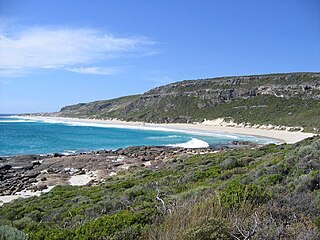
Eucalyptus marginata, commonly known as jarrah, djarraly in Noongar language and historically as Swan River mahogany, is a plant in the myrtle family, Myrtaceae and is endemic to the south-west of Western Australia. It is a tree with rough, fibrous bark, leaves with a distinct midvein, white flowers and relatively large, more or less spherical fruit. Its hard, dense timber is insect resistant although the tree is susceptible to dieback. The timber has been utilised for cabinet-making, flooring and railway sleepers.

Leeuwin-Naturaliste National Park is a national park in the South West region of Western Australia, 267 km (166 mi) south of Perth. It is named after the two locations at either end of the park which have lighthouses, Cape Leeuwin and Cape Naturaliste. It is located in the Augusta-Margaret River and Busselton council areas, and is claimed to have the highest visiting numbers of any national park in Western Australia. The park received 2.33 million visitors through 2008–2009.

The Darling Scarp, also referred to as the Darling Range or Darling Ranges, is a low escarpment running north–south to the east of the Swan Coastal Plain and Perth, Western Australia. The escarpment extends generally north of Bindoon, to the south of Pemberton. The adjacent Darling Plateau goes easterly to include Mount Bakewell near York and Mount Saddleback near Boddington. It was named after the Governor of New South Wales, Lieutenant-General Ralph Darling.

Manjimup is a town in Western Australia, 307 kilometres (191 mi) south of the state capital, Perth. The town of Manjimup is a regional centre for the largest shire in the South West region of Western Australia. At the 2016 census, Manjimup had a population of 4,349.

South Western Highway is a highway in the South West region of Western Australia connecting Perth's southeast with Walpole. It is a part of the Highway 1 network for most of its length. It is about 406 kilometres (252 mi) long.
Wagerup is a town located in the Peel region of Western Australia just off the South Western Highway. It is located between Waroona and Harvey, 12 km (7.5 mi) south of Waroona.

The South Western Railway, also known as the South West Main Line, is the main railway route between Perth and Bunbury in Western Australia.

Great Walk Networking, also known as Great Walk Network, is a bushwalking community in Western Australia. The Great Walk started in 1988 as a protest walk from Denmark to Parliament House in Perth, to raise awareness of logging in Western Australia's old growth forests.
The Conservation Council of Western Australia is the umbrella body for conservation groups and organisations in Western Australia. It has been the co-ordinator, publisher and guiding body for issues of woodchipping in the South West of Western Australia, the logging of old growth forests, as well as providing input into government processes involved with all aspects of environmental protection and conservation.

Warren, also known as Karri Forest Region and the Jarrah-Karri forest and shrublands ecoregion, is a biogeographic region in southern Western Australia. Located in the southwest corner of Western Australia between Cape Naturaliste and Albany, it is bordered to the north and east by the Jarrah Forest region. Its defining characteristic is an extensive tall forest of Eucalyptus diversicolor (karri). This occurs on dissected, hilly ground, with a moderately wet climate. Karri is a valuable timber and much of the karri forest has been logged over, but less than a third has been cleared for agriculture. Recognised as a region under the Interim Biogeographic Regionalisation for Australia (IBRA), and as a terrestrial ecoregion by the World Wide Fund for Nature, it was first defined by Ludwig Diels in 1906.
South West Forests Defence Foundation (SFDF) is a group that has been involved in the conservation of the jarrah and karri forests of the South West region of Western Australia for more than four decades.
The West Australian Forest Alliance is an organization made up of a number of Western Australian environmental activist groups concerned with the destruction of old-growth forests in the South West region. It has published a range of posters and documents. It is a successor to and includes membership of the earlier groups the Campaign to Save Native Forests, South West Forests Defence Foundation, Great Walk Networking, and other member groups of the Conservation Council of Western Australia.

Woodchipping is the act and industry of chipping wood for pulp. Timber is converted to woodchips and sold, primarily, for paper manufacture. In Australia, woodchips are produced by clearcutting or thinning of native forests or plantations. In other parts of the world, forestry practices such as short rotation coppice are the usual methods adopted.
The W.A. Chip & Pulp Company was founded in 1969 to export woodchips from sustainable bluegum plantations after the Government of Western Australia granted a Bunnings led consortium rights to establish a woodchip project in Manjimup. In August 2000, the business was sold to Marubeni.

The network of railway lines in Western Australia associated with the timber and firewood industries is as old as the mainline railway system of the former Western Australian Government Railways system.
Jarrah forest is tall open forest in which the dominant overstory tree is Eucalyptus marginata (jarrah). The ecosystem occurs only in the Southwest Botanical Province of Western Australia. It is most common in the biogeographic region named in consequence Jarrah Forest.

The Donnelly River is a river in the South West of Western Australia. Its main tributaries are Barlee Brook and Carey Brook. The river runs primarily through state forest reserves, although 25 private landholdings are situated along the length of the river. Clearing of the catchment area is estimated at 20% with the land mostly being used for viticulture, horticulture, dairy, grazing and tourism.
The Warren River is a river in the South West region of Western Australia with a catchment encompassing the towns of Manjimup and Pemberton. The river was named by Governor James Stirling, probably after Admiral Sir John Borlase Warren under whom Stirling served whilst in action in North America in 1813.

The 1976 Bunbury woodchip bombing was an unprecedented and politically motivated act of property destruction that took place at a woodchip export terminal in Bunbury, Western Australia. More than 1000 sticks of gelignite were planted by two environmental protesters with the resulting partial detonation causing an estimated $300,000 in damages. The intention of the bombing was to prevent the export of woodchips from Western Australian old growth forests for 18 months. This act of protest is now largely unknown outside of Western Australia but was considered to have been a serious setback for the emerging environmental movement at the time—despite the perpetrators being unaffiliated with any environmental organisation.
Beth Schultz is an Australian environmentalist. She has campaigned for the preservation of the Karri forests in the south-west of Western Australia since 1975.











